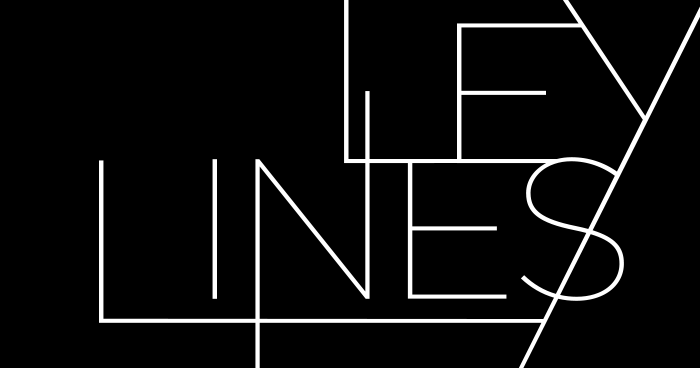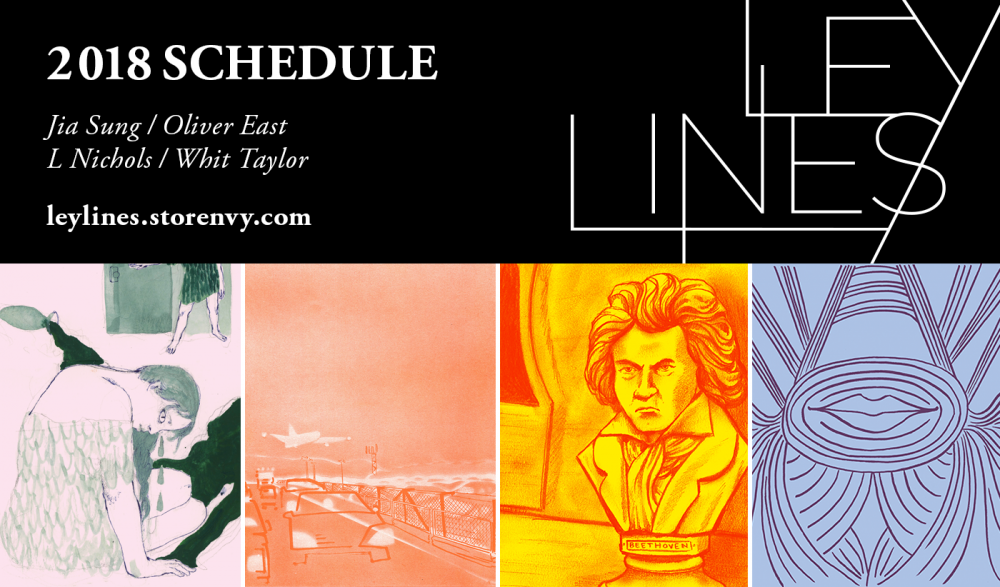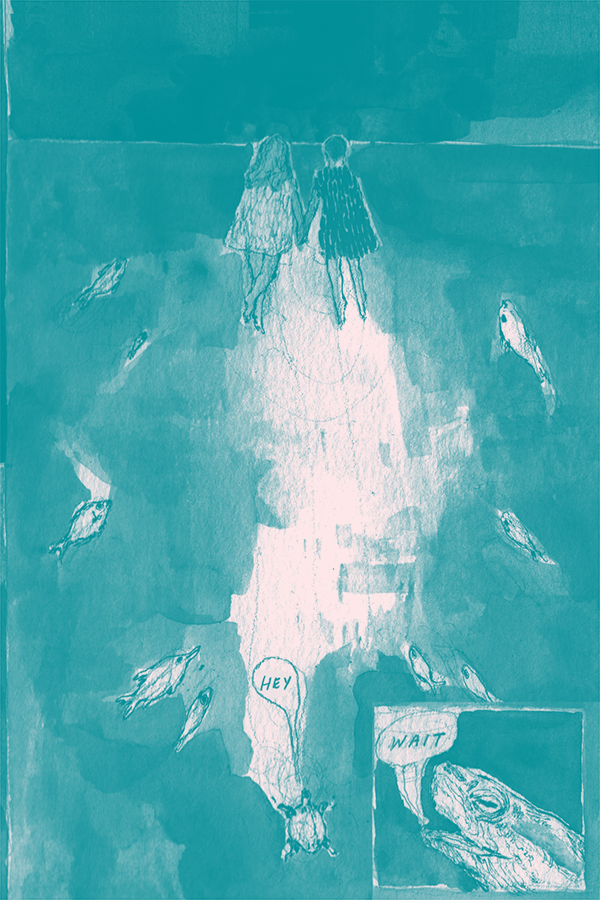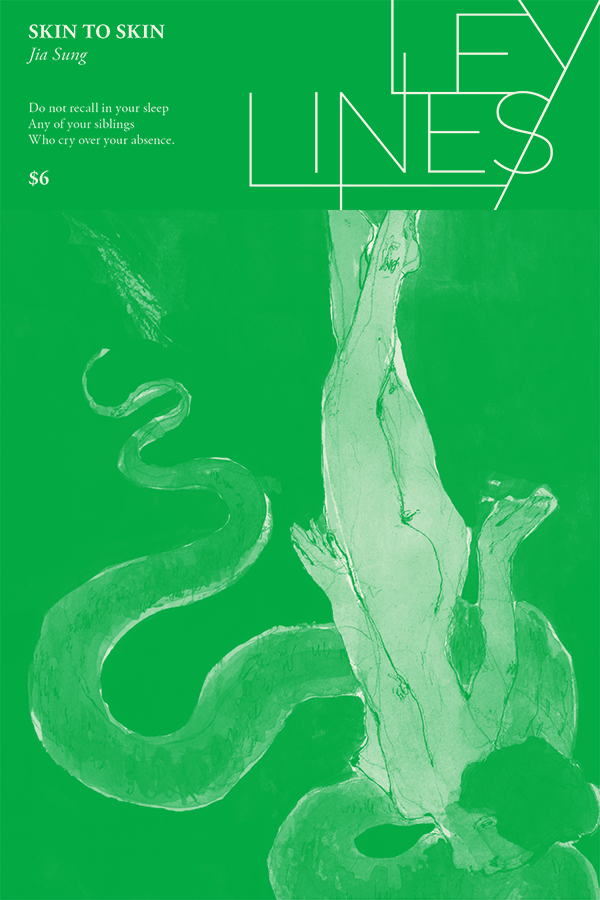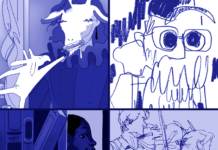Ley Lines is a project I’ve followed closely since it’s launch in 2014. The mission statement of Kevin Czap & L Nichols, the founders of this quarterly publication is ambitious, Ley Lines (…) is dedicated to exploring the intersection of comics and the various fields of art & culture. In essence, having a dialog between comics and the world of fine art. It’s a bold and necessary endeavour that has been rewarding since the very first issue. Kevin Czap and L Nichols graciously accepted to talk with me about their recently announced comics for 2018, the genesis of Ley Lines, their own connections with art and artists as well as their own issues of Ley Lines.
—
Philippe Leblanc: You’ve just announced the 2018 line up of Ley Lines.
L Nichols: Yes, We’re going to have issues from Whit Taylor, Oliver East and Jia Sung, who’s a Brooklyn-based cartoonist.
Kevin Czap: L is doing an issue as well.
Philippe Leblanc: Before we dive in and talk about Ley Lines, I kind of want to bring it back to the beginning before I talk about Ley lines. For those readers who may not be familiar with you and your work, can you tell us a little bit about yourself?
KC: I had the pleasure of doing a number of different things within Comics. I’m sort of not really content just focus on one lane. L and I originally started working together co-editing Comix Cube with Darryl Ayo. Comix Cube was a criticism blog and it contained the seeds of what turned into Ley Lines. I also make my own comics. When I lived in Cleveland, I helped organize a small press convention and I’m the publisher of a comics micro-press called Czap Books. I also had a book released by Uncivilized Books this past October. It’s like an idealized dreamy Science Fiction comics called Fütchi Perf. It’s my first major book as a cartoonist. I co-publish Ley lines with L. About 2 years ago, I relocated to Providence, Rhode Island and spent the past couple months as the fellow at the Center for Cartoon Studies.
It’s been an interesting trajectory. I never really had a master plan besides just “being involved in comics” so it’s been very mono-focus. Just doing comics in one way or another is what I wanted to do.
PL: Am I remembering correctly, you had a crowdfunding campaign for the publication of Fütchi Perf and other books like Witchlight or am I misremembering?
KC: That was separate. Our Kickstarter was for Witchlight, which has come out, and for a book by Liz Suburbia and another one by Kelly Kwan.
PL: And what about L?
LN: I started writing comics when I was in college as a way to stay sane. I never really read them growing up so I don’t know why I was drawn to them, but I always was. Ever since I started drawing them my friends were the ones who really convinced me to turn them into zines. I’ve been printing my own stuff for, I don’t know, it’s been a little over ten years, 2005 was my first work. I do this collection of comics that I just publish randomly whenever I have a bunch that I can put together. Sometimes it’s autobiographical, sometimes experimental; it’s kind of all over the place. I don’t stick in one area too long typically. I have a graphic novel coming out from Secret Acres this September and it’s the longest thing I’ve done. It’s called Flocks. It’s autobiographical. Flocks was hard for me because it’s very personal emotional to do and was a relief to do and be done with and not working on a giant project, but then I was kind of lost now. I’m excited I have the Ley lines book this year. It gives me something to work on.
My issue is going to be about Beethoven. I play piano. It’s another thing I do mostly for myself, I’ve played growing up and stopped for a really long time but I’ve gotten back into it recently. I do a lot of things I guess. What else do I do…I paint, blacksmith. I like hiking. Cooking too.
PL: So you can say “multidisciplinary artist with varied focus”?
LN: Yes you could say that. I do a lot of things and comics are just one major thing I do.
PL: Ley Lines is a “quarterly publication dedicated to exploring the intersection of comics and the various fields of art & culture that inspire us”? Why did you decide to work together on this project? What were the initial sparks that convinced Czap Books & Grindstone comics to work together?
LN: When I was in school at MIT, I took some classes from Henry Jenkins, he teaches media studies and media sciences and his specialty is on fan culture. His focus is on popular culture, but it got me thinking “where is the fandom for fine arts and culture”? That idea just stuck with me. Is there a fan cultures and for something we don’t normally consider to have fans. We didn’t want it to be ironic. We wanted it to be heartfelt. I think it’s the core of everything I do. I tend to be very sincere and capturing the moment of connection with another artist was something we wanted to have. I think it’s captured in these books.
I feel like Kevin and I talked about this idea a lot and it was brewing. I think it coalesced when I was talking with Annie Mok and she said she wanted to do an issue of this on Egon Schiele. That’s when I thought, “Well, I guess we have to do this now”!
KC: It’s already begun. For me with regards to Ley Lines, I went to art school and the dominant narrative against comics was absent. I didn’t feel like people were telling me that Comics were stupid or that I couldn’t be interested in them and still make serious art so I never I never felt that Schism. I was really into performance art and site-specific installation and just like the whole world of Contemporary Art from the fifties and eighties
In my own work, I’m always pulling from other concepts and art forms, trying to think of how they are made, studying those structures and trying to translate them into my work. I do this especially with music and songs. I’m always looking at songs or music album structure and trying to work that into my work. When L and I were working on Comix Cube, a lot of the things for our writing we were circling around was this idea of connection. Injecting comics into other areas of thought and art forms so after we ran out of time to maintain that Comix Cube, we still wanted to work together. We started talking about the idea of something similar to this project together and then L had already gotten the ball rolling on Ley Lines so I we were already too invested. I had to try and catch up.
PL: How has the reaction to Ley Lines been since the launch of the series?
LN: It’s been better than I was expecting. Honestly, like it has been really good. From the original idea to seeing it out in the world and how people are reacting to it has been very heartwarming, touching and sweet. I think it’s my favourite thing I work on.
PL: Each issue are risographed with a specific colour, page number and size. How did the decision to focus on this format came about?
KC: When we were starting, there was a lot of back and forth as to what it should like. We took inspiration from a photography magazine. We came up with a really minimal cover that was just this simple standard template
LN: There was also a magazine or journal that had a different artist featured with each issue. We thought it was great because they have a consistent look. Every issue can be individualized by the artist but it remains coherent and cohesive. The size, I don’t know, I like that it is a smaller book that is more manageable. That’s something we can ask an artist to do is not too ridiculous a task. It’s not like asking for a 400 page book for nothing, or not much money. We thought it would be manageable for artists and for us with our busy lives. I wanted to make a nice thing you can hold that looks great. Kevin and I both do graphic design ad we looked at what we could do as a template.
KC: It really looks nice now that it accumulated over the years to see them all spread out. It’s interesting to see the choices people make for their cover.
LN: We let the artists pick the colour paper and ink they want. It’s interesting to see who picks what and like we start seeing trends last year there was a lot of red tones.
PL: So you leave the artist pick which paper in what color they want.
KC: The format that’s set is just the size, banner and page count, that it’s one color risograph and then we try and leave everything else open to the artist. We’ve always given them a large percentage of the print run for them to sell on their own. It wasn’t until down the road until Annie Koyama got involved that we got to pay them like a little bit but even still it’s not.
LN: Really it’s not nearly enough of a fair compensation so we want it to be something they’re proud of and that they’d want to do for themselves. It’s something to have for the artists own body of work so really it doesn’t make sense to us to demand anything.
PL: The books mention you are supported by Koyama Press. Could you let us know what their roles are in Ley Lines?
KC: It’s no secret that Annie is like the Saint of our scene or of this era of small press comics. L and I have known Annie for several years and she’s lived up to all the legends and stories you may have heard. She’s an angel and a fan of the series and she believes in it. From what she’s communicated, her motive is just to make sure that we keep making Ley Lines. She believes in the project and she wants to make sure that we’re still doing it so she’s like making sure of that by helping out and supporting us.
PL: Yes, Annie donated a huge collection of American alternative and indie cartoonists’ original art to the Billy Ireland Museum and she’s trying to do something similar for Canadian artists to a Canadian Museum too. She’s incredible.
PL: You’ve just announced your line up for 2018 with new issues by Oliver East, Jia Sung, Whit Taylor and L Nichols. Can you give us some more details about these new issues? L you mention your issue will be about Beethoven. It should be interesting to see how you pour your musical influences into comics.
LN: I’m curious to see what happens too, hopefully it works.
KC: You’ve been thinking about this for over a year.
LN: Yes, the most coherent thing I know is how I want it to be structured. I don’t know haven’t drawn a lot recently.
KC: You’ve been doing these workouts too. One thing to know though is that L and I both come from sort of the same group where artists Warren Craghead, Oliver East and Alyssa Berg and others that are influenced by poetry. It’s like “Team Weird Comics” if you wish. Every November, there’s 30 days of comics were we make a comic a day, which I think a lot of people do, but this particular group is very into the idea of there being constraints. So whenever it begins, you have to pick your constraint and then that determines how you make your daily comics for the month. We still kind of work like that, setting up constraints to clarify things at the beginning of project. We like to have to pick a structure.
LN: It’s a big component of my work overall. Flocks is coming out, but it’s the most anomalous work I’ve done because it’s consistent and long and has a narrative and most of my other stuff is not like that.
PL: So we shouldn’t expect a narrative from the Beethoven book?
LN: No, I’ll try to do a hybrid where there are three sections and some interpretation of the music. It will be about Beethoven’s piano music. In particular, I’m interested in his piano sonatas. I have been trying to learn this one Sonata for a year-and-a-half now. I’m at the point where I can play through the first movement okay, but definitely not at the speed that it should be.
How do you talk about working on something that you’re doing for yourself? It’s been a long time, a year and a half of playing this same piece almost every single day.
I’m thinking whether I can learn how to play it properly. Am I going learn to play this the way I want to? The practice of doing it and doing it right is what drives me. My mind has to be focused to keep going back to a musical piece again and always finding something new in it and through the action of playing it and learning how to do it. It’s about this excessive love. I want my book to touch on that, this connection you can make across hundreds of years with an artist. Someone else interacting with the work of an artist.
I’m a comic artist and a lot of people see my work and discover ”me”, but the place where I feel like I’m expressing myself the most is when I’m alone playing the piano.
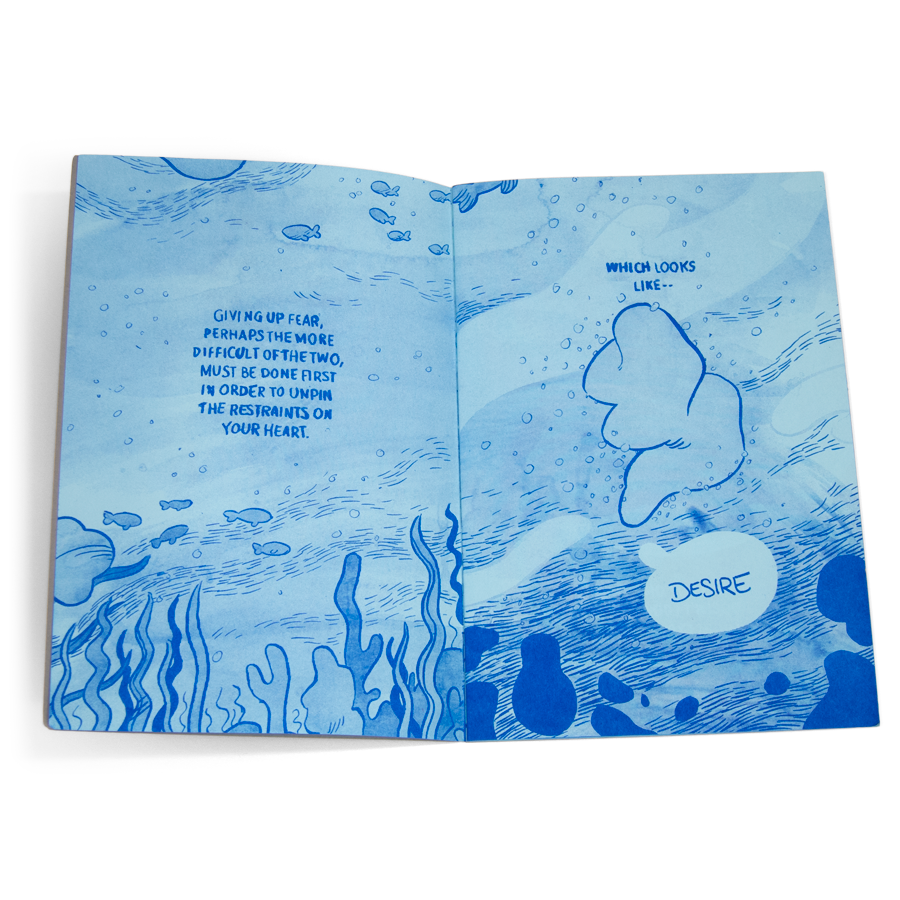
PL: It’s interesting that you’re approaching the idea of how Beethoven influenced you in your work. I’d be interesting to hear Kevin talk about how he made his own issue last year about an artist influenced him. How did you approach that?
KC: I’m going to stop and remember because that was two years ago so I need to set my mind back to it.
When we started, L and I each said we have to do an issue. I think we both had our ideas in mind that we wanted to do. For the actual comic, it’s about the artist and the work of Bas Jan Ader, largely his piece I’m Too Sad to Tell You which is like this photo and a series of videos of him just like sobbing. I’d always been interested in his engagement with vulnerability and how it’s kind of serious but also kind of a joke. It’s like this weird tenuous balance and then his other pieces involve videos of him falling off of rooftops or falling from a bike or into a canal. He explored these various modes of failure, which especially as a college student, I feel like I related to maturing a bit from working and on growing out of some of those self-destructive tendencies.
The tragedy of Bas Jan Ander is that his final piece involved him getting lost at sea. There’s this fine line between “suicide through art” or just a horrible like a project gone awry. The narrative theme of my issue is to reverse that. If you can sort of emerge out of the water and survive, walk back on land again. It was dealing with vulnerability. I think I wanted it to be a really personal comic so in that way it’s difficult to really like talk about. Since there are a lot of personal elements there, I was scrapping at ideas in my mind that I don’t quite have the words for.
They’re more based on a feeling and I was also pulling from a lot of other I was interested at the time in Marina Abramovic and in infusing a transcendent element of certain performance art.
And going back to music structure I think I tried to take a song and started to map it out like it was a piece of poetry. Where are the rhyme sets and where does it break down percentage-wise? I tried to map whatever I was drawing according to that emotional ark. Too much going on in one comic perhaps.
PL: Since the launch of Ley Lines in late 2014, you’ve published a wide array of comic artists with vastly different takes on what art and specific artists mean to them. Do you feel like it it’s easier to define what Ley Lines is now that you have such a wide range of work to showcase?
LN: I can’t believe it’s been that many years. No, it mostly just makes me feel nervous that I feel like everyone’s done such beautiful work. I have to step up my game. I feel I have to push myself in a way that. I don’t know if I feel this way from a lot of other projects I work on. I feel like all the artists have brought in a lot of love to their issues and I want to live up to that.
KC: I feel like I’ve learned more from how each one comes across and mine is only like one portion of that. I get more of a sense of the series as it goes on and we see more variations and seeing it living up to the promise of the series
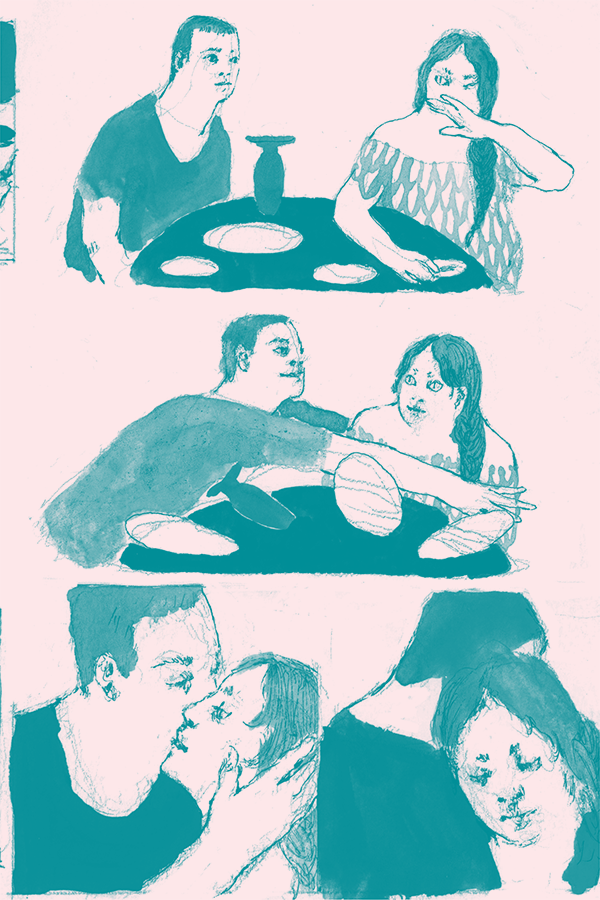
PL: Going back to your line up for 2018. You have Oliver East, Jia Sung, Whit Taylor making their own issues too.
LN: I’m really excited for this year’s lineup and to see Jia’s issue. Jia’s so nice. She already knew of Ley Lines and really liked the series.
KC: Jia is a graduate of RISD and I think I first met her at a convention or zine show in Cambridge maybe for the first time. She’s an amazing painter. The first thing I got of hers was a zine that had which was a combination of poetry and these painted illustrations with watercolor.
Not everybody who makes comics likes other kinds of art like Fine Art but there’s this certain group that you can kind of tell would be interested in Ley Lines. Jia was clearly someone who we thought last March or April at MOCCA. We were like ”Jia is going to do it right?” and she was in right away.
The issue she’s done is the one that’s been turned in so far for this year. It’s based off of Madame White Snake which I’m less familiar with. It’s from Belkis Ayon, a Cuban artist and writer and I think it’s a take on fairy tales and a retelling in these paintings and maybe also some writing from a feminist viewpoint.
LN: Ayon was a print maker and she would do collages and play with different textures and method of prints. I didn’t know about her work before Jia turned me onto it and I was like “oh wow” it made me want to go to find out more about this which is nice what I want.
LN: My favourite thing about Ley Lines is that the people who read them are not only introduced to something that they didn’t know before, but they are introduced to it through the eyes of someone who is passionate about it. That’s important to me. There’s not as much enthusiasm in the fine art. People tend to be more detached or talk about it academically, but I wanted this passion. It’s what I’m drawn to. Jia does a really good job to introduce us to Belkis Ayon.
PL: And you feel the same way about Whit Taylor, that she was also bringing this kind of passion to her issues as well?
KC: Whit had been talking about a few ideas and ultimately settled on this one really interesting story. When she was a kid she played the Mona Lisa in a school play, that’s the impetus for her issue and I am very curious to see how it turns out.
LN: Whit brings in this really personal connection to her story. For Oliver, he’s somebody that we’ve both known for quite a while and always been huge fans of his work.
KC: Every year with Ley Lines we have somebody who can really portray the landscape of what comics can do, somebody who really does something out of left field that’s amazing. The first year, we had Erin Curry who does amazing abstract and sculptural comics and much like Oliver, was really from the same kind of school of thought with regards to comics. I think Oliver’s in grad school right now and really deep into philosophy, so some of his ideas are based on the profound boredom. That’s something I would have never thought about exploring in a comics form. It’s a pretty heady concept.
PL: There’s so many different ways to approach the idea of connection with arts. I’m thinking of what Eric Kostiuk Williams did for his issue about Kylie Minogue or Laila Milevski on gothic architecture. It’s a good showcase of what comics can be about. I’m looking forward to the 2018 lineup.
LN: We just announced the lineup in late February and we’re going to have subscriptions available and starting on March 1st. They’re going to be up for the whole year but specifically in March they’ll be on sale.
—
You can subscribe to Ley Lines on their website. If you’ve missed any of the previous issues, you can also find them on their online store.


